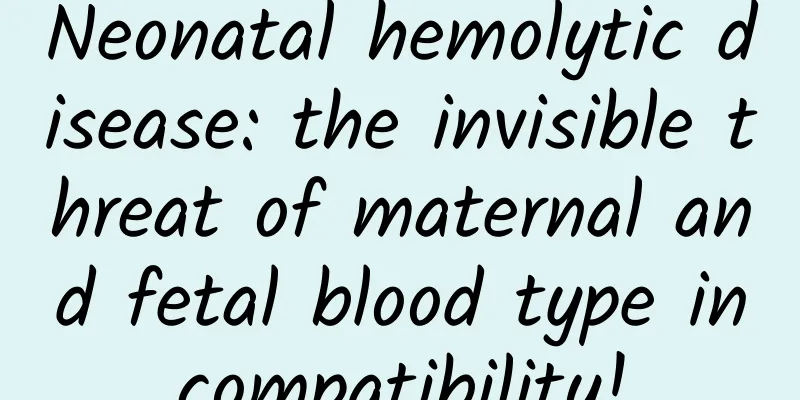Neonatal hemolytic disease: the invisible threat of maternal and fetal blood type incompatibility!

|
Author: Zhong Yan, Chief Physician, Beijing Children's Hospital, Capital Medical University Reviewer: Meihua Park, Chief Physician, Peking University Third Hospital Hemolytic disease of the newborn, as an isoimmune hemolytic disease caused by maternal-fetal blood type incompatibility, is one of the important causes of early neonatal jaundice. Its clinical manifestations are diverse, ranging from mild jaundice to severe anemia, fetal edema and even bilirubin encephalopathy, posing a threat to the health of newborns that cannot be ignored. Hemolytic disease of the newborn is mainly caused by incompatibility of blood types between mother and baby, especially the mismatch between the ABO blood type system and the Rh blood type system. Among the 26 blood type systems that have been discovered, the ABO and Rh blood type systems are particularly critical due to their universality. According to statistics, ABO blood type incompatibility hemolytic disease accounts for about 85% of hemolytic disease of the newborn, while Rh blood type incompatibility hemolytic disease accounts for about 14%. In addition, other rare blood type systems such as the MN blood type system may also cause hemolytic disease, but the incidence is extremely low. For the ABO blood group system, when the mother is type O blood and the father is type A, B or AB blood, the risk of hemolysis in the newborn increases significantly. This is because the mother with type O blood may contain antibodies against A or B antigens, which may enter the fetus through the placenta during pregnancy or delivery, triggering an immune response, leading to red blood cell destruction and hemolysis. The Rh blood type system is more complex, including multiple antigens such as D, C, E, c, and e. Rh positive means that the individual's blood type antigen contains D antigen, while Rh negative does not. When an Rh-negative mother gives birth to an Rh-positive father, if the fetus is Rh-positive, Rh hemolytic disease may occur. It is worth noting that even if both parents are Rh-positive, if the mother lacks certain Rh antigens carried by the fetus (such as E antigen), hemolysis may also occur. Symptoms of neonatal hemolytic disease vary in severity, depending on the degree of hemolysis, the degree of sensitization of fetal red blood cells, and the fetal compensatory ability. Mild hemolysis may only manifest as jaundice, while severe hemolysis may be accompanied by severe symptoms such as anemia, fetal edema, hepatosplenomegaly, bleeding tendency, and even bilirubin encephalopathy. Figure 1 Original copyright image, no permission to reprint Jaundice is one of the most common clinical manifestations of neonatal hemolytic disease, which is characterized by early onset (usually within 24 hours after birth), rapid rise and high jaundice values. Compared with physiological jaundice, hemolytic jaundice is more severe and does not easily disappear on its own. In addition, the severity of anemia is also directly related to the degree of hemolysis. Severe anemia may lead to life-threatening complications such as heart failure and dyspnea. Bilirubin encephalopathy is one of the most serious complications of hemolytic disease, and it often occurs in children with particularly severe hemolysis and extremely high bilirubin levels. Its clinical manifestations can be divided into warning period, spasm period, recovery period and sequelae period. Children in the warning period may experience non-specific symptoms such as weak sucking and weakened response; if not treated in time, they may enter the spasm period and experience serious symptoms such as changes in muscle tone and convulsions; eventually, they may be left with sequelae such as athetosis, hearing impairment, eye movement disorders and enamel hypoplasia. Diagnosis of hemolytic disease of the newborn requires comprehensive clinical manifestations, blood typing, bilirubin and hemoglobin level determination, and anti-human globulin test (Coomb's test) results. In particular, the anti-human globulin test can directly detect whether red blood cells are sensitized and is a key means of diagnosing hemolytic disease. Figure 2 Original copyright image, no permission to reprint The key to preventing hemolytic disease of the newborn lies in early identification and intervention. For pregnant women at risk of hemolytic disease, blood typing and antibody screening should be performed during pregnancy so that timely detection and measures can be taken. For Rh-negative pregnant women, if their husbands are Rh-positive and the titer of anti-RhD antibodies in the pregnant woman (mother) is monitored to be relatively high, anti-RhD immunoglobulin can be infused to the pregnant woman (mother) during pregnancy to reduce the risk of hemolytic disease of the newborn. For children diagnosed with neonatal hemolytic disease, appropriate treatment measures should be taken according to the severity of the disease. Children with mild hemolysis may only need close observation and supportive treatment; while children with severe hemolysis need timely exchange transfusion therapy to reduce bilirubin levels and prevent the occurrence of bilirubin encephalopathy. In addition, phototherapy is also one of the important means of treating hemolytic jaundice. By irradiating the skin with light of a specific wavelength, unconjugated bilirubin is converted into water-soluble isomers and excreted from the body. |
>>: Do not underestimate nasal congestion and hyposmia: Clinical warning of occult nasal tumors
Recommend
Are you anxious about your body shape?
Author: Chen Han, deputy chief physician of Shang...
If your child suddenly develops a lump on his body that appears and disappears, it is likely a hernia!
Why does a small bump suddenly appear on your chi...
There are spots between the two breasts
In recent years, with the pollution of the living...
Causes of vulvar itching and whitening
Have female friends ever experienced itchy and wh...
How many months of pregnancy do you not need to take folic acid?
In the early stages of pregnancy, you should supp...
Bleeding in early pregnancy like menstruation
Bleeding in early pregnancy is like menstruation....
Can I take a bath and wash my hair during the confinement period?
I heard from the elderly that you cannot wash you...
Should you gain weight in autumn? Here are some tips on keeping fit in autumn
People often say "bitter summer", which...
Simple ways for girls to lose weight on their arms
I want to wear a beautiful camisole, but my arms ...
Can I sleep on my back when I am 5 months pregnant?
Can you sleep lying flat when you are five months...
This disease is actually gender-specific? Come and see what's going on!
There is a disease in which the male-to-female ra...
What is the normal size of the ovaries?
The ovaries are the standard of us as women, and ...
What hot compress should I use for dysmenorrhea
Many women suffer from dysmenorrhea. Working for ...
What causes prostate hyperplasia? What should you pay attention to?
Prostatic hyperplasia, also known as prostate enl...
What is secondary infertility?
In life, many young people are unable to conceive...









